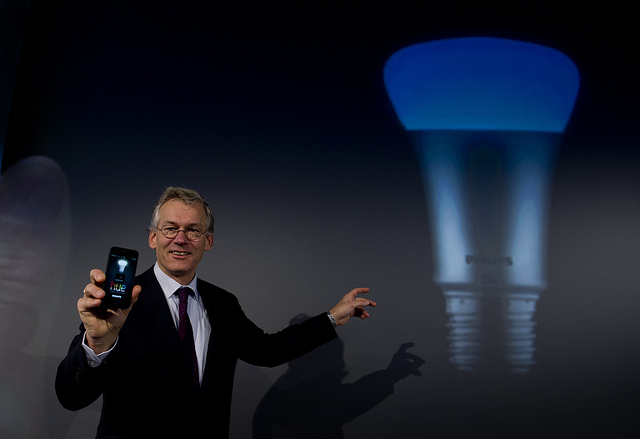Following the spin-off of Osram from Siemens, global lighting giant Philips recently announced it would split off its lighting business into a stand-alone company on September 23. That move follows an announcement in June that Philips would combine Lumileds, its LED components business and automotive lighting business into a separate company.
Although Philips is a top player in the global lighting industry with thehighest market penetration, the Dutch company’s earnings before interest, taxes and amortization (EBITA) have long been less than 10 percent for. One reason for that is Asian manufacturers’ tenacity in the electronics and semiconductor industries, where they enjoy lower manufacturing costs and higher product cost/performance (C/P) ratios. Additionally, Philips Lighting is gradually losing its market competitiveness with the rise of LED lighting.
 |
|
Philips CEO Frans Van Houten introducing Philips Hue during the product's launch. The company recently announced it will split its lighting and health care business. (Photo Credit: Philips) |
Job cuts to hit lighting industry
Philips’ restructuring may also result in significant job cuts. The Philips Group has more than 113,000 employees worldwide, but its massive corporate structure has attracted much criticism in recent years. Stifling bureaucracy in the company’s multi-level organizational structure has offset benefits from Philips’ economies of scales. After Osram split from Siemens, the company underwent large-scale layoffs, and has slashed more than 10,000 jobs in the past year.
Philips might also follow Osram’s example of implementing major job cuts after the lighting business restructure. The Dutch firm estimated the new operating structure would enable cost savings of EUR 100 million in 2015, and a further EUR 200 million by 2016. The recent developments also indicate the lighting industry will be seeing a wave of career changers.
Opportunities for Asian lighting OEMs to become Philips Lighting shareholders
Philips Lighting and Philips Lumileds might be independently listed on the bourse in the near future, and Philips has not ruled out introducing new investors to finance the new companies to alleviate the group’s financial risks. The new stand-alone companies will develop independent decision-making mechanisms to enable quick responses to market activity.
At the same time, Asian LED lighting manufacturers that have long been Philips OEM, component suppliers, or even direct competitors in lighting channels might become Philips shareholders in the future. Once Philips issues stocks, these Asian manufacturers can share the fruits of Philips’ long years of labor.
Few changes in LED supply chain in the near future
Regarding the LED industry’s top concern, there will be few changes in Philips Lighting supply chain in the near future, according to LEDinside. Since 2013, the Philips Group has moved LED procurement decision rights to Philips Lumileds. Ahead of the Philips Lumileds listing, there will be few changes in LED procurement strategies.
Top Taiwanese and Chinese LED manufacturers are all members of Philips Lumileds supply chain, but restructuring in the chain is expected after new shareholders enter the new stand-alone Philips Lumileds and Philips Lighting companies.












